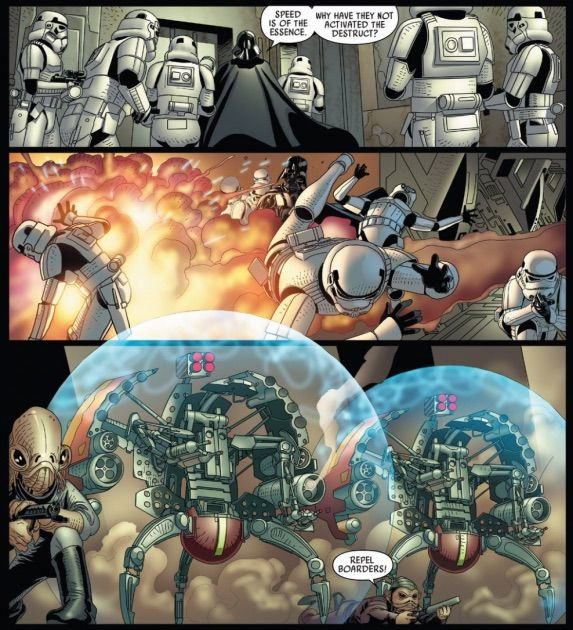The Marvel Star Wars comics have had an incredible roll-out so far, with Star Wars #1 now standing as one of the bestselling comics ever released. The release of the second Marvel Star Wars comic, Darth Vader, was no slouch either, with nearly 200,000 copies sold of Darth Vader #1.
While the Jason Aaron-written Star Wars series has managed to keep our interest, even as it delves into the low-stakes territory between Star Wars and Star Wars: Episode V The Empire Strikes Back, Darth Vader #1 failed to justify the same existence, in essence spreading too little butter over too much bread. Darth Vader #2, written by Kieron Gillen with art by Salvador Larroca, fares a lot better.
Darth Vader #2 gives us new settings and refreshes Star Wars tropes with expert deployment of minor characters and, oddly enough, some out-of-place Star Wars Prequel Trilogy technology. But Darth Vader #2’s greatest success, and a decision I hope flavors all of the Marvel Star Wars comics, is the strange sympathies produced by witnessing Darth Vader get treated like Bantha poodoo (which, I just learned, is Bantha food, not shit… weak).
Marvel Star Wars Comics Steps it up with Darth Vader #2
In Darth Vader #1 we learn that Emperor Palpatine is still pissed at Vader for failing to protect the Death Star from destruction by the Rebel Alliance at the end of Star Wars. This isn’t all that surprising, presumably the Emperor is disappointed by minions all the time.
Darth Vader #2 emphasizes Vader’s new outsider status in more dramatic ways, first by putting him under the command of Grand General Tagge, then compounding the embarrassment by assigning an Imperial adjutant to spy on Vader’s communications. In case you don’t recognize the name Tagge, it’s the guy arguing against getting too cocky about the Death Star in this scene:
Unfortunately, Tagge isn’t the dude who Vader Force Chokes. That would be Admiral Motti. Still, establishing Tagge’s ascendancy in the aftermath of the Death Star’s destruction in Star Wars is the kind of thoughtful internal politics that enriches the strange bureaucracy that grounds the more mystic aspects of the Sith Emperor’s reign. Grand General Tagge stepping in as Darth Vader’s antagonist in the Marvel Star Wars universe feels thematically rich; a conflict between traditional military regimentation and Darth Vader’s singular villainy. Darth Vader may be as haughty and defiant as ever in Darth Vader #2, but it’s interesting to see how he goes about proving his worth in a Star Wars Empire that doesn’t automatically quiver in terror at his every proclamation.
Darth Vader vs. Grand General Tagge
Darth Vader #2 opens with Vader and Tagge debating how to handle a robotic corvette that has been raiding Imperial ships for supplies. Vader is skeptical of Tagge’s holographic analytics (“Attrition is high, but does not map outside of the predictable piracy in my models”), preferring his own instinct that a mole in the Imperial fleet is helping to funnel stolen supplies to the raiders.

“Tarkin had vision. You have graphs,” Vader tells Tagge, but is soon put in his place by the Grand General. Not only will Vader lead the strike team on the raiders base — Tagge prefers to treat Vader like a frontline weapon than a Sith Lord — but he’s also been assigned Lieutenant Oon-Ai, whose only job seems to be spying on Vader for Tagge.
Oon-Ai and Vader don’t get off to a great start, with Oon-Ai immediately digging into Vader’s emails and prodding him about his mysterious meeting with Boba Fett in Darth Vader #1 (Vader hires Boba Fett to track down Luke Skywalker).
The Action Sequence That Elevates Darth Vader #2
Using the captured pirate corvette as a trojan horse, Vader, Oon-Ai, and a bunch of stormtroopers raid the pirate base, which turns out to be stealing Imperial supplies for a mysterious crime syndicate known as the Crymorah. Here Vader is in his element, not only acting unflappable as Oon-Ai cowers, but secretly sending out a droid across the ship’s surface to upload data connecting Oon-Ai to the pirates.

This tense action scene, and Darth Vader’s simultaneous subterfuge, elevates Darth Vader #2 above not only its previous issue, but also above the main Marvel Star Wars comic, Star Wars. While the Marvel Star Wars comics are in their infancy, Darth Vader #2 is the best single issue yet. While Darth Vader makes quick work of them, the reappearance of Star Wars Prequel Trilogy droidekas is handled well, as if the pirates had dug up an ancient trump card.
But it’s Darth Vader’s betrayal of Oon-Ai that does the most for Darth Vader as a character. Not only does it feel in keeping with the Darth Vader of the Star Wars movies, for whom life is cheap, but it demonstrates a cunning we just don’t get out of Vader in the Star Wars Original Trilogy. Vader isn’t killing impulsively, strangling dudes for mistakes, but planning out a murder to maintain his own autonomy and simultaneously call Tagge’s policies into question.
The final page of Darth Vader #2, with Vader jettisoning the droid that could incriminate him into space before intoning, “Droids. One can always trust droids…” is just downright heartbreaking. Darth Vader has always stood alone in the Star Wars universe, but the Marvel Star Wars comics have captured the tragedy of Vader better in Darth Vader #2 than any Star Wars story since the end of Star Wars: Episode VI Return of the Jedi. But unlike Return of the Jedi, Marvel comics did it with Darth Vader’s helm still firmly in place.


















